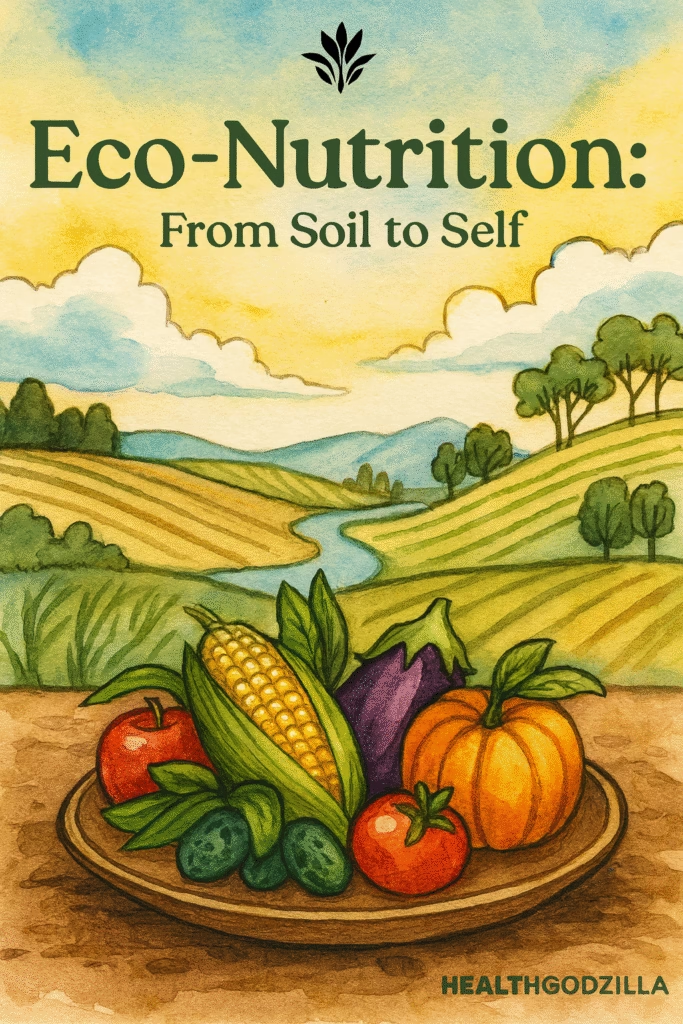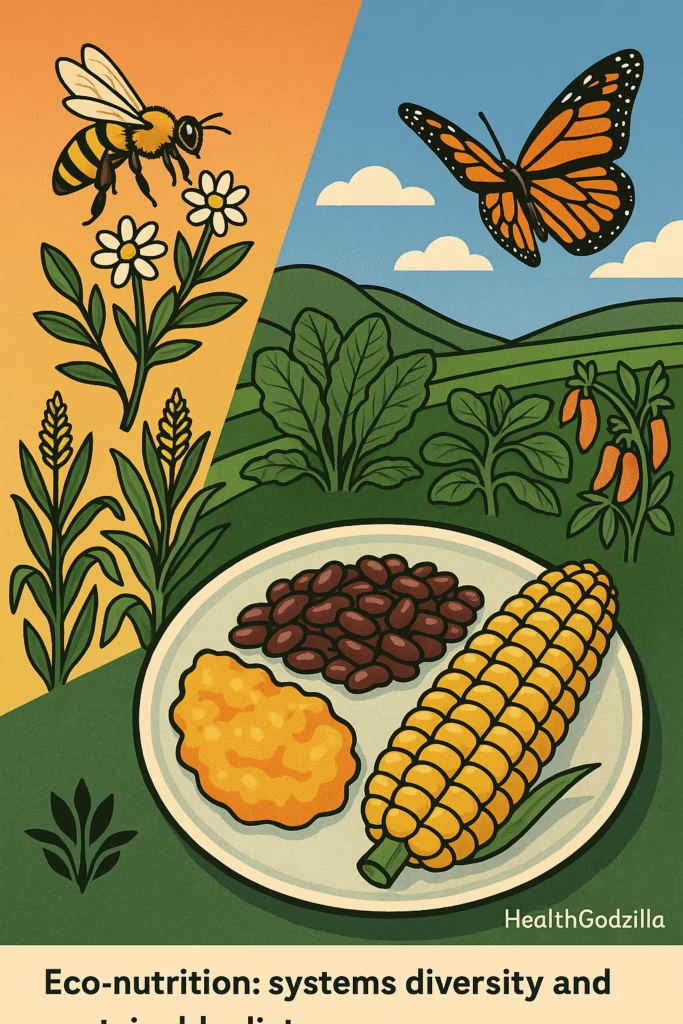
Prologue — A Seed Between Earth and Body
Every forest whispers the same lesson: diversity is survival. A woodland of only one tree is brittle; a meadow of one flower cannot summon bees. Life steadies itself through variety, each species lending a note to the greater song. Our bodies are no different. A diet stripped to sameness grows silent, its notes thin, its harmony broken—this is the truth Eco-Nutrition carries between soil and soul.
Eco-nutrition is the bridge—stretching from soil to soul. It tells us that the richness of ecosystems and the richness of human diets mirror one another, each sustaining the other. When biodiversity fades from the land, it fades from the plate. And when it fades from the plate, resilience slips quietly from our bodies.
Yet this is the road we have chosen. Fields across the world now shimmer with sameness—endless seas of wheat, rice, and maize. Our diets echo that monotony, offering plenty of calories but little of the deep nourishment once woven through traditional harvests. In our pursuit of yield, we have traded diversity for uniformity, resilience for fragility.
The urgency is not abstract. With every vanished seed variety, with every pollinator lost, we lose both flavors and futures. Eco-nutrition asks us to pause and look again: what we sow into earth, we reap into ourselves. Diversity is not decoration—it is the condition of health, the quiet architecture of survival.
Act I — The Hidden Hunger of Homogeneity
Walk through the farmlands of today, and you will see oceans of sameness: rice stretching like water across Asia, wheat fields shimmering golden through Europe, maize rising tall across the Americas. At first glance, it looks like abundance. Yet beneath this uniform beauty hides a silent erosion. Our tables are fed by only a handful of crops, and this narrow diet, like a monoculture field, breeds fragility.
From the thousands of edible plants once woven into human diets, barely a few dozen now dominate the global market. Wheat, rice, and maize together provide more than half of humanity’s calories. They fill stomachs, yes, but they do not fill the deeper need for resilience or richness. Calories alone cannot carry the full chorus of vitamins, minerals, and bioactive compounds that once came from diverse harvests.
The danger of this uniformity is twofold. In the soil, monocultures invite pests, diseases, and collapse—fields without variety cannot buffer shock. In the body, uniform diets weaken immunity, shorten the span of nourishment, and leave hidden hungers unfulfilled. This is the paradox of modern agriculture: in chasing efficiency, we have grown more vulnerable.
Contrast a plate of white rice and bread with one adorned by millet, beans, leafy greens, yams, and wild fruits. The difference is not only in color, taste, or tradition—it is in survival. Diversity on the plate mirrors diversity in the field; both build layers of resilience that protect against famine, disease, and ecological change.
Yet hope stirs in the margins. Scattered across the world’s landscapes are neglected and underutilized species—grains, roots, pulses, and fruits that still hold the memory of balance. Amaranth that thrives in drought, fonio that ripens faster than hunger, wild greens rich in iron and folate. These are the whispers of agrobiodiversity, waiting to be recalled from silence.
The hidden hunger is not simply about empty stomachs—it is about empty choices. And eco-nutrition reminds us that restoring variety to our fields and diets is not nostalgia, but necessity.
Act II — Food Systems at the Crossroads
If Act I revealed the narrowing of crops, Act II reveals the widening cracks in the systems that deliver them. Our food systems sit at the tangled intersection of climate change, malnutrition, and inequity. They are both culprit and casualty—shaping the planet’s wounds while being wounded in return.
The paradox is stark: never before has the world produced so much food, and never before have hunger and obesity walked so closely hand in hand. This is the double burden of malnutrition—children stunted by lack of nutrients in one village, while in another, ultra-processed foods crowd out tradition and health, leading to obesity, diabetes, and heart disease. It is not two problems but one: a food system that feeds but does not nourish.
Inequity threads through every bite. In wealthy neighborhoods, fresh produce gleams under soft supermarket lights, while in food deserts, families find only shelves lined with sugar, salt, and fat. Affordability builds invisible walls—nutritious foods priced beyond reach, while corporate giants lobby to keep profits polished, not plates. The choices of the many are constrained by the influence of the few.
Yet here lies a turning point. The old narrative of “feeding the world” has been measured in calories, in tonnage, in yields. But calories are not enough; a world fed can still be a world unwell. The new narrative must be one of nourishing the world—measured not just in fullness of stomachs, but in fullness of health, equity, and sustainability.
To nourish rather than merely feed is to rethink what success looks like. It is to count diversity as wealth, access as justice, and sustainability as survival. It is to place eco-nutrition not at the margins, but at the very center of our future.

Act III — Eco-Nutrition and Systems Diversity
Ecology and nutrition are mirrors, each reflecting the same quiet law: diversity is resilience. A forest thick with many species withstands storms; a diet filled with many foods withstands deficiencies. When variety fades—whether from the canopy or the plate—collapse is never far behind.
This truth is not new. The ancients knew it in their hands and in their meals. Consider the “three sisters” of the Americas: maize, beans, and squash planted side by side in the same soil. Together they were more than food—they were a system. Maize gave carbohydrates, beans offered protein, squash brought vitamins, and the trio’s roots and vines shielded the earth from hunger and erosion alike. When maize later traveled to other continents without its sisters, the harmony broke; pellagra and deficiencies followed. Wisdom had been lost in translation.
Diversity, then, is not just about counting species but about the functions they bring. Five grains from the same family cannot nourish as fully as five foods drawn from different roots of life. A field of wheat, rice, and maize may boast abundance, but a field of millet, beans, squash, sweet potato, and guava offers resilience—nutritional and ecological alike. This is functional diversity: the strength that comes when variety complements, rather than repeats itself.
Yet today, the erosion of diversity threatens not only crops but the very agents of fertility—pollinators. Bees, butterflies, birds, and bats, quiet laborers of the earth, carry more than sweetness from flower to flower; they carry nutrition itself. Vitamins A, C, and folate ride on their wings, bound within the fruits, seeds, and vegetables they help bring to life. As pollinators decline, the risk of hidden hunger rises—not in calories, but in the micronutrients that shield us from disease. A world without pollinators would not only be poorer in beauty, but hungrier in health.
Eco-nutrition calls us to see these threads as one cloth: soil, crop, pollinator, plate, and body. Systems diversity—ecological and dietary—is not a luxury. It is the scaffold of survival.
Mirror I — Diets as Landscapes, Landscapes as Diets
A plate is never just a plate—it is a landscape in miniature. Grains echo fields, fruits recall orchards, fish whisper of rivers and seas. Each meal is geography made edible, and each landscape is a hidden diet in waiting.
The idea of nutrition-sensitive landscapes asks us to make this truth visible: to design land use where biodiversity, agriculture, and health do not compete but conspire together. A watershed that holds clean water, fields where pollinators still hum, forests that cradle edible fruits, and markets that bring them within reach—such landscapes nourish not only ecosystems, but people.
Land, water, pollinators, and food are not separate compartments but one breathing network. If water runs foul, so does health. Bees vanish, and vitamins vanish with them. As forests fall, diets thin. Each ecological fracture finds its echo in human bodies. Eco-nutrition makes this echo audible, insisting that health policy and land policy, diet and soil, cannot be split apart.
To embrace eco-nutrition is to accept a worldview of interdependence. It is to see the body as part of the landscape, the landscape as part of the body. A forest feeds more than air; it feeds memory, resilience, and tomorrow’s harvest. A field is more than yield; it is the possibility of renewal. In this mirror, our diets and our landscapes blur, until one truth remains: to heal one, we must heal both.
Mirror II — Systems Diversity Beyond the Plate
Diversity does not end in fields or forests. Systems diversity stretches further—into politics, culture, and economics. A seed may sprout in soil, but it also sprouts in policies, in markets, in the choices that shape what reaches a table. To think eco-nutrition is only about food is to miss the wider weave.
For too long, our systems have bowed to a single measure: yield. How many tons, how many bushels, how many calories per acre. But a full silo does not guarantee a nourished child. Transformation means shifting from yield-maximization to value-maximization: asking what kind of food, for whom, at what cost to health, equity, and earth.
Food must be seen not as a mere commodity, shuffled through markets, but as a common good—woven into the dignity of people and the fabric of communities. To reclaim this truth demands what some call a business-unusual approach. Subsidies must no longer reward uniformity, but variety. Incentives must no longer favor bulk, but balance. Food environments must be reimagined—not aisles of processed sameness, but spaces where real nourishment is accessible, affordable, and celebrated.
Systems are not neutral—they are shaped by power. When corporations dictate what grows and what sells, when subsidies reward sameness, when culture is flattened into convenience, the result is a narrowing of choices masked as abundance. To restore systems diversity is to restore sovereignty: of farmers to plant, of communities to choose, of cultures to keep their foodways alive.
Systems diversity beyond the plate is the architecture of justice. Without it, eco-nutrition remains a whisper. With it, eco-nutrition becomes a chorus, resonating from soil to society.
🍂 Hello, Artista — A Shared Meal Across Cities

The evening settled differently in two cities. In Vancouver, Artista stood at her kitchen table, arranging heirloom tomatoes in shades of amber and crimson, a bundle of kale still cool with the memory of morning dew. Whitee and Brownie, her rabbits, nosed the edges of a carrot top, as if reminding her that food is always shared across species.
She laughed softly, sending a message across the ocean of wires to Organum:
Artista: “The market today was alive, Organum. I picked beans with purple streaks and squash that looked as though it had stored a little sun inside. When I eat them, I feel I am eating the season itself. Do you ever feel that?”
In Boston, Organum sat in his small kitchen, the light harsh from the ceiling bulb. His plate bore supermarket bread, slices of processed cheese, and a handful of grapes in a plastic clamshell. RD barked somewhere in the background, chasing after Gulli’s mischievous tail.
He sighed before replying:
Organum: “Sometimes I stand in the aisles, staring at boxes with bright pictures but no memory inside. It’s food that fills but doesn’t speak. I long for something rooted—a meal that tells me where it has come from. Your beans sound like stories. My bread feels like silence.”
Artista paused, hearing the ache between his words.
Artista: “Maybe that’s eco-nutrition, my friend—not just what nourishes the body, but what carries the soil’s voice into our kitchens. Each plate a map of relationships: farmer, seed, pollinator, season, memory. A meal is never only food—it is system, soil, and story.”
Organum smiled, feeling the truth stretch across the distance.
Organum: “Then tonight, even with this quiet bread, I’ll eat with your tomatoes in mind. Perhaps the taste of variety travels better than we think.”
And in that small exchange, across borders and plates, eco-nutrition lived—spoken not in policy or yield, but in companionship and choice.
✍️ Author’s Reflection — A Root Beneath Words
Eco-nutrition is a seed—small, quiet, often overlooked. Yet within it lies the memory of forests, the strength of rivers, the hum of pollinators, the wisdom of farmers, the resilience of bodies. To plant it is to connect earth’s biodiversity with our own survival, to admit that health is never separate from habitat.
The ancients knew this truth in their polycultures: maize, beans, and squash dancing together in the soil, offering not just food but completeness. The earth still remembers, though we often forget. And the bees remind us with their fragile buzzing—that without them, vitamins and fruits may slip away, leaving diets hollow and futures thin.
Eco-nutrition is not a theory to be concluded, but a rhythm to be lived. It does not offer a final word but an invitation: to taste, to remember, to protect.
I was not alone when I wrote this. Others spoke, and I listened.
Rigid things crack, but roots learn to weave around stone.
So let this seed travel with the reader—carried in thought, planted in choice, sprouting wherever soil and soul are willing to meet.
—Jamee
🌼 Articles You May Like
From metal minds to stardust thoughts—more journeys await:
- Groupthink and Leadership: Born or Made in the Mindset Mirror. Groupthink and leadership—twin forces shaped by mindset. Explore how silence, dissent, and growth define whether leaders are born or made.
- Waterborne Diseases: When Rivers Whisper of Illness and Hope. Waterborne diseases whisper through rivers both as menace and as plea—explore how clean water can heal communities, narrated by Zarvan.
Curated with stardust by Organum & Artista under a sky full of questions.
📚 Principal Sources
- Fanzo, J., Rudie, C., Sigman, I., Grinspoon, S., Benton, T. G., Brown, M. E., Covic, N., Fitch, K., Golden, C. D., Grace, D., Hivert, M.-F., Huybers, P., Jaacks, L. M., Masters, W. A., Nisbett, N., Richardson, R. A., Singleton, C. R., Webb, P., & Willett, W. C. (2021). Sustainable food systems and nutrition in the 21st century: A report from the 22nd annual Harvard Nutrition Obesity Symposium. American Journal of Clinical Nutrition. PMCID: PMC8755053.
- Alliance of Bioversity International & International Center for Tropical Agriculture. (2019). Including Food Systems, Biodiversity, Nutrition and Health in the Post-2020 Global Biodiversity Framework. Submission to the Convention on Biological Diversity.
- World Health Organization, & Secretariat of the Convention on Biological Diversity. (2015). Connecting global priorities: Biodiversity and human health: A state of knowledge review. Geneva: World Health Organization.
Relevant chapters and sections were interpreted through a narrative lens rather than cited academically.
This article is also archived for open access on Zenodo: https://zenodo.org/records/17116213. Archiving ensures its permanence in the scholarly record.

Leave a Reply